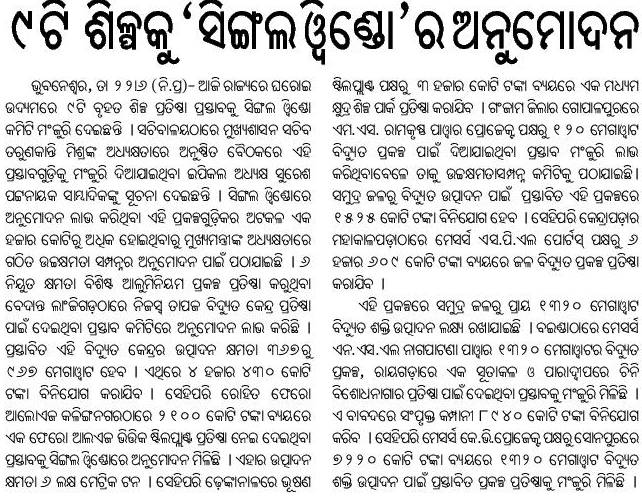With Orissa witnessing a rush of investment proposals in the iron and steel sector, the domestic and overseas steel majors are exploring the possibilities of developing small and medium enterprises (SMEs) around the large units proposed by them.
Tata Steel is developing a six-million tonne greenfield steel project at Kalinga Nagar, the emerging steel hub of the country. The firm has identified business opportunities worth Rs 12,000 crore in the ancillary and downstream units.
“The opportunities for ancillary and downstream units exist in the areas of operations and maintenance, core specialised services, support specialised services, processing and township management, to name a few. There can be different working models for development of local SMEs as ancillaries and downstream units. One such model includes Tata Steel and other steel majors working together with their ancillary partners in Orissa,” said K Shankar Marar, assistant general manager, (steel technology, at Tata Steel’s Kalinga Nagar project.
… Another steel major, JSL, (formerly Jindal Stainless Limited), is keen on developing an industrial park based on downstream stainless steel industries, spread over an area of 300 acres as a part of its SEZ (special economic zone) in Orissa’s Jajpur district.
The SEZ is being developed at an investment of around Rs 700 crore. JSL has engaged US-based consultant CB Richard Ellis for developing a business plan for the project wherein opportunities for downstream industries will be explored.
The SEZ is set to provide direct employment to 3,800 workers besides generating indirect employment for 1,200 others.
Posco which has announced an investment of about Rs 52,000 crore for a 12 million tonne steel plant near Paradeep is also committed to development of ancillary and downstream units and the steel giant has engaged IIT-Kharagpur for a study on the opportunities that exist in this area.
According to a study conducted by IIT-Kharagpur for Posco India, opportunities for SME entrepreneurs exist in the areas of structural steel, ready mixed concrete, refractory, steel and concrete piles, pipes, propeller shafts and furnace building to name a few.
According to the study, opportunities also exist in other operational areas like steel probes, mould flux, thermos materials, manufacture and fabrication of structures, conveyor belts and electrical equipment repairs.
The study adds that business opportunities worth Rs 320 crore exist in the area of refractory, Rs 44 crore for cement, Rs 2.5 crore in hydraulic hoses and Rs 4 crore in wire rods. The first phase of Posco India’s project would generate 35,728 labour intensive jobs and another 30,420 technology intensive jobs.
… Aarti Steel has already started its efforts for developing SMEs as ancillaries for its steel plant in the state.
“We have sourced items and spare parts worth Rs 37 crore from 47 local partners till March 2008. Aarti Steel plans to develop two forging units adjacent to its steel plant for the benefit of the local entrepreneurs and we have approached IDCO to provide land for these units”, said a senior official of Aarti Steel.
On its part, the Orissa government plans to incorporate a clause at the MoU (memorandum of understanding) level with the private steel players to ensure that the mother industries will make necessary efforts for development of ancillary and downstream units.
The efforts made by the steel units to develop the ancillary units will be monitored by officials like district collectors and revenue district commissioners.
BS reported that the 6million tonne per annum greenfield steel project proposed by TATA Steel in Kalinganagar will require maintenance support services worth INR 1,200 crore when fully commissioned. These services will be outsourced by the company and are expected to create huge opportunities for the small and medium enterprises in Orissa.
The services to be outsourced include warehousing, machine shop, electrical repairing shop, fabrication shops, electrodes and lubricant suppliers, waste management, mechanized material handling and hospitality among others. Since the maintenance cost is about 4% of the total investment in steel industry, this is expected to create huge opportunities for the small and medium enterprises.
Mr B K Singh VP Orissa project of TATA Steel said that "We will invest about INR 30,000 crore in the Kalinganagar project in phases and will require maintenance support services worth INR 1,200 crore.”
He added that the group will work towards developing the local entrepreneurs and will provide assistance to anyone who wants to be a partner in TATA Steel’s business. He added that TATA Steel will give the first right of refusal to local industries in the maintenance support services.

